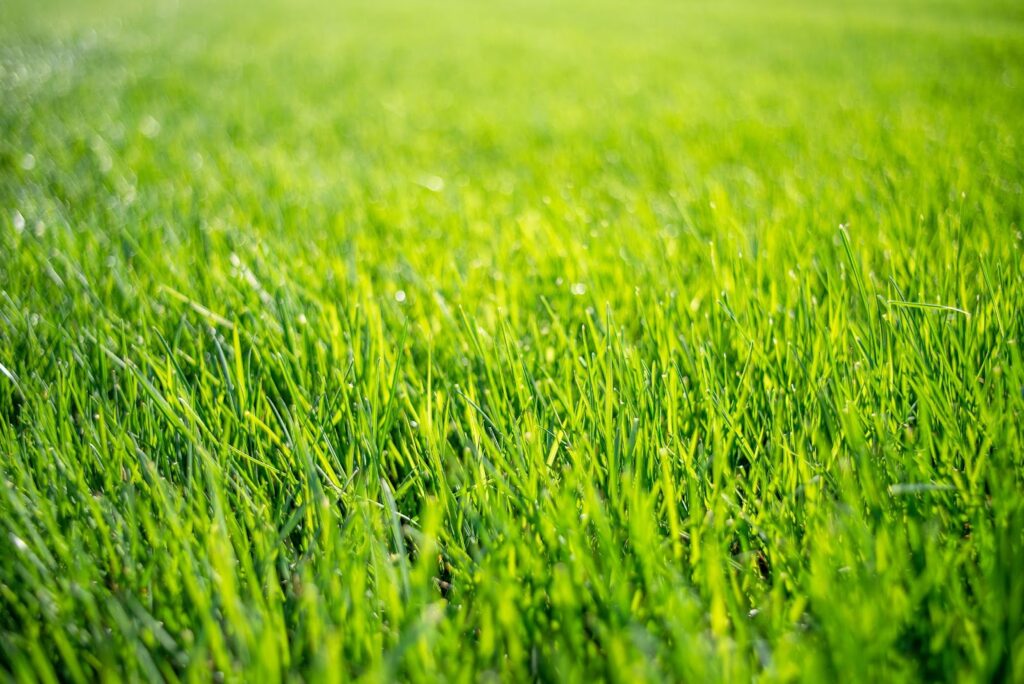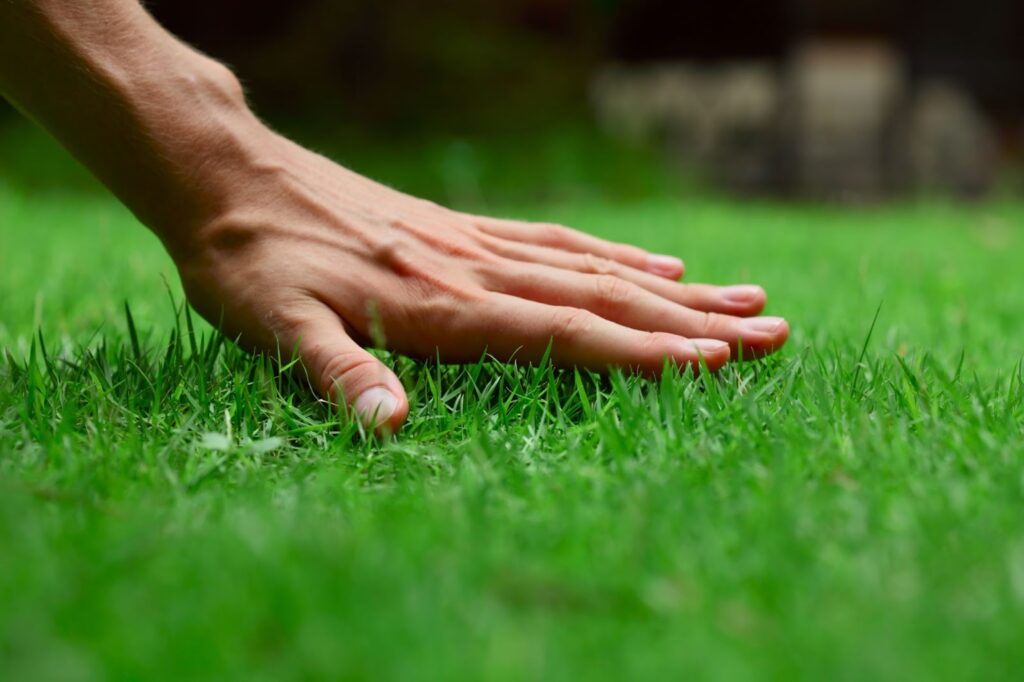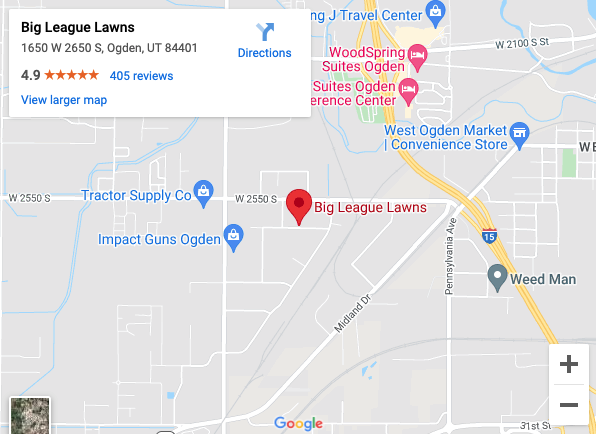Liquid lawn aeration is a groundbreaking approach that revitalizes your lawn by creating micro-pores in the soil, allowing water, oxygen, and nutrients to reach grass roots more effectively. This method is an effortless way to enhance lawn health, improve soil structure and promote beneficial microbial growth without needing heavy machinery.
Contrasted with mechanical aeration, which physically breaks up soil through puncturing or coring, liquid aeration offers a seamless and less disruptive option. While mechanical aeration is great for tackling severe compaction with immediate results, it is labor-intensive and tough on your lawn’s appearance.
On the other hand, liquid aeration treats your entire lawn evenly, making it ideal for sensitive grass types and hard-to-reach areas, ensuring a lush, healthy lawn with minimal effort.
Choosing between liquid and mechanical aeration boils down to your lawn’s specific needs and your preference for convenience versus immediate impact. Both play vital roles in a holistic lawn care approach, each with benefits tailored to different lawn conditions and maintenance goals. Understanding these options allows you to make the best choice for a vibrant, flourishing lawn.
Benefits of liquid aeration
Embracing liquid aeration unfolds myriad benefits for your lawn, enhancing its beauty and overall health from the roots up. This gentle yet powerful soil conditioning method revolutionizes how we care for our lawns, ensuring that the very foundation of your green space thrives.
Elevating soil structure and root growth
Liquid aeration works wonders on soil structure, transforming compacted, hard-to-penetrate earth into a loose, fertile bed that encourages root expansion. Breaking down compact soil at a molecular level fosters an environment where roots stretch out and grow deeper and stronger.
This robust root system is the backbone of a healthy lawn, enabling it to withstand stress and flourish.
Boosting water, nutrient, and oxygen uptake
The magic of liquid aeration and using soil conditioner lies in its ability to enhance the soil’s absorption abilities. The created micro-pores ensure that water, essential nutrients, and oxygen effortlessly reach the roots, where they’re most needed. This efficient pathway prevents wasteful runoff and pooling, ensuring every drop and every granule of fertilizer contributes to the vitality of your lawn.
Environmental benefits
Choosing liquid aeration is a win for your lawn and a victory for the environment. This method reduces the need for excessive watering and fertilizer use, cutting down on runoff, and leading to nutrient pollution in our waterways. Liquid aeration diminishes reliance on chemical treatments by fostering a healthier lawn that is naturally resistant to pests and diseases. This makes it a friendlier choice for the planet.
When to apply liquid lawn aeration
Choosing the perfect moment to introduce liquid aeration into your lawn care regimen is crucial for maximizing its benefits. Timing varies significantly depending on your climate and the type of grass that adorns your garden. Let’s navigate through the optimal periods for liquid aeration, ensuring your lawn receives this vital treatment when it’s most receptive.

Timing liquid aeration by grass type and climate
Cool-season grasses
For those nurturing cool-season varieties like bluegrass, fescue, or ryegrass, early spring or early fall are the golden windows for liquid aeration. These periods align with the grass’s natural growth spurts, allowing your lawn to heal and utilize the treatment most effectively before the stress of summer heat or winter cold.
Warm-season grasses
If your lawn boasts warm-season stars such as Bermuda, Zoysia, or St. Augustine, late spring through early summer marks the ideal time. As these grasses enter their peak growing season, liquid aeration enhances their health, preparing them to face high temperatures with robust root systems.
Recognizing the need for liquid aeration
Your lawn will often signal when it needs some aeration attention. Keep an eye out for these telltale signs:
- Water runoff: If water consistently pools or runs off without soaking into the soil, it’s a clear indicator that compaction is preventing proper absorption.
- Hard soil: When the surface feels hard to the touch or your gardening tools struggle to penetrate the earth, compaction has likely taken hold, making liquid aeration necessary.
- Uneven growth: Patches of your lawn that grow poorly or not at all, despite proper watering and fertilization, might be crying out for aeration to improve soil conditions.
- Heavy use: Areas that see frequent foot traffic, be it from pets, children, or during gatherings, are prone to compaction and greatly benefit from liquid aeration.
How to apply liquid aeration products
To unleash your lawn’s full potential with liquid aeration, start by prepping your lawn and choosing the right product. First, mow your lawn for smoother application and effective soil penetration. Then, water your lawn thoroughly one day before to enhance the treatment’s absorption.
When selecting a liquid aeration product, prioritize ingredients like humic acid and seaweed extract that boost soil health and microbial activity. Tailor your choice to your lawn’s needs, focusing on products suited for either dense soil or regular upkeep.
Applying liquid aeration soil conditioner
To apply liquid aeration soil conditioner effectively, select suitable equipment like a hose-end sprayer for small lawns or a backpack sprayer for larger areas, ensuring they’re clean and calibrated.
Always adhere to the product’s label for dilution rates and application instructions to guarantee safety and effectiveness.
Apply the product evenly across your lawn, starting from one corner and moving systematically to avoid over-application. Water your lawn post-application in order to enhance soil penetration.
For the best results, regularly incorporate liquid aeration into your lawn care routine and adjust the application frequency or product type as needed, based on your lawn’s response. This careful approach primes your lawn for vibrant health and beauty.
Aftercare: maximizing the benefits of liquid aeration
After lovingly applying liquid aeration to your lawn, the journey towards a lush, vibrant garden isn’t over. Proper aftercare is crucial to maximizing the benefits of this treatment, turning the promise of healthier soil and stronger roots into a stunning reality.
Let’s explore how to nurture your lawn in the wake of liquid aeration and ensure that every effort blooms into visible beauty.
Hydration is key
Immediately after applying liquid aeration, thoroughly water your lawn. This helps the aeration solution seep deeper into the soil, further enhancing its effectiveness.
For the next few weeks, monitor your lawn’s moisture level. The goal is to keep the soil consistently moist but not waterlogged to support the newly aerated environment and encourage root growth.
Overseeding opportunities
Liquid aeration creates the perfect conditions for overseeding, especially in areas where grass is thin or patchy. The improved soil environment encourages seed-to-soil contact, germination, and growth.
Choose grass seed that matches your existing lawn and is appropriate for your climate. Spreading seeds evenly over the target areas ensures comprehensive coverage and a uniform look.
Complementary lawn care practices
Regular mowing
Continue mowing your lawn at the recommended height for your grass type. This encourages healthy growth and helps evenly integrate new grass seeds into your lawn.
Pest and weed management
Watch for pests and weeds, which take advantage of the disturbed soil. Use eco-friendly options for control and prevention, maintaining the health and beauty of your lawn without harsh chemicals.
Soil testing
Consider conducting a soil test a few weeks after liquid aeration. This provides valuable insights into your soil’s pH and nutrient levels, allowing you to further tailor your lawn care practices.
Embrace these practices, and watch as your lawn transforms into a vibrant, resilient paradise that’s a joy to behold.

Professional liquid aeration services vs. DIY
When it comes to liquid aeration, deciding between rolling up your sleeves for a DIY project or calling in the professionals is a pivotal choice. Each route has its benefits and considerations, tailored to different needs and preferences.
Let’s delve into the pros and cons of professional liquid aeration services versus the DIY approach, helping you make an informed decision for your lawn.
Professional liquid aeration services
Pros
Expertise on demand: Professionals bring a wealth of experience, ensuring your lawn receives the precise treatment it needs. They can spot issues you might overlook and offer tailored solutions.
Time-saving convenience: Hiring experts frees up your time. Instead of navigating the nuances of liquid aeration yourself, you can enjoy your weekend while the pros handle the task efficiently.
Access to superior products: Professionals often have access to high-grade, commercial products unavailable to the average homeowner, potentially offering better results for your lawn.
Cons
Cost considerations: Expert services come with a price tag. If budget constraints are a concern, this might be a significant factor in your decision-making process.
Scheduling constraints: You’ll need to work within the service provider’s schedule, which might not align perfectly with your timing or the optimal aeration window for your lawn.
DIY liquid aeration: taking the reins
Pros
Cost-effective: The DIY route can be more wallet-friendly, especially if you have a smaller lawn or already possess some garden savvy.
Flexibility and control: You decide when and how to aerate, allowing you to tailor the process to your lawn’s specific needs and your personal schedule.
Learning and satisfaction: There’s a unique sense of accomplishment and empowerment in caring for your lawn personally. You’ll learn more about your lawn’s needs and how to meet them.
Cons
Learning curve: If you’re new to liquid aeration, there might be a bit of trial and error as you learn the ropes. Mistakes happen, and they can affect your lawn’s health.
Product availability: While many quality liquid aeration products are available to consumers, finding the right one for your lawn’s specific needs might require some research.
Time and effort: Be prepared to dedicate time and physical effort to the task. While not as labor-intensive as mechanical aeration, the DIY liquid aeration process still demands attention to detail.
Making your choice
Choosing between professional services and a DIY project for liquid aeration boils down to your priorities, whether they’re cost, control, convenience, or learning. Regardless of your choice, the aim is a vibrant, healthy lawn achieved through the transformative power of liquid aeration.
Liquid lawn aeration and soil conditioning from Big League Lawns
Big League Lawns stands ready to elevate your lawn care game. With our deep understanding of soil health, access to premium aeration products, and commitment to personalized care, we’re here to ensure your lawn receives the best treatment possible. Let us take the hassle out of lawn maintenance, allowing you more time to enjoy the beauty of your outdoor oasis.
Reach out to Big League Lawns today for a free lawn analysis and take the first step toward a healthier, more beautiful lawn.



